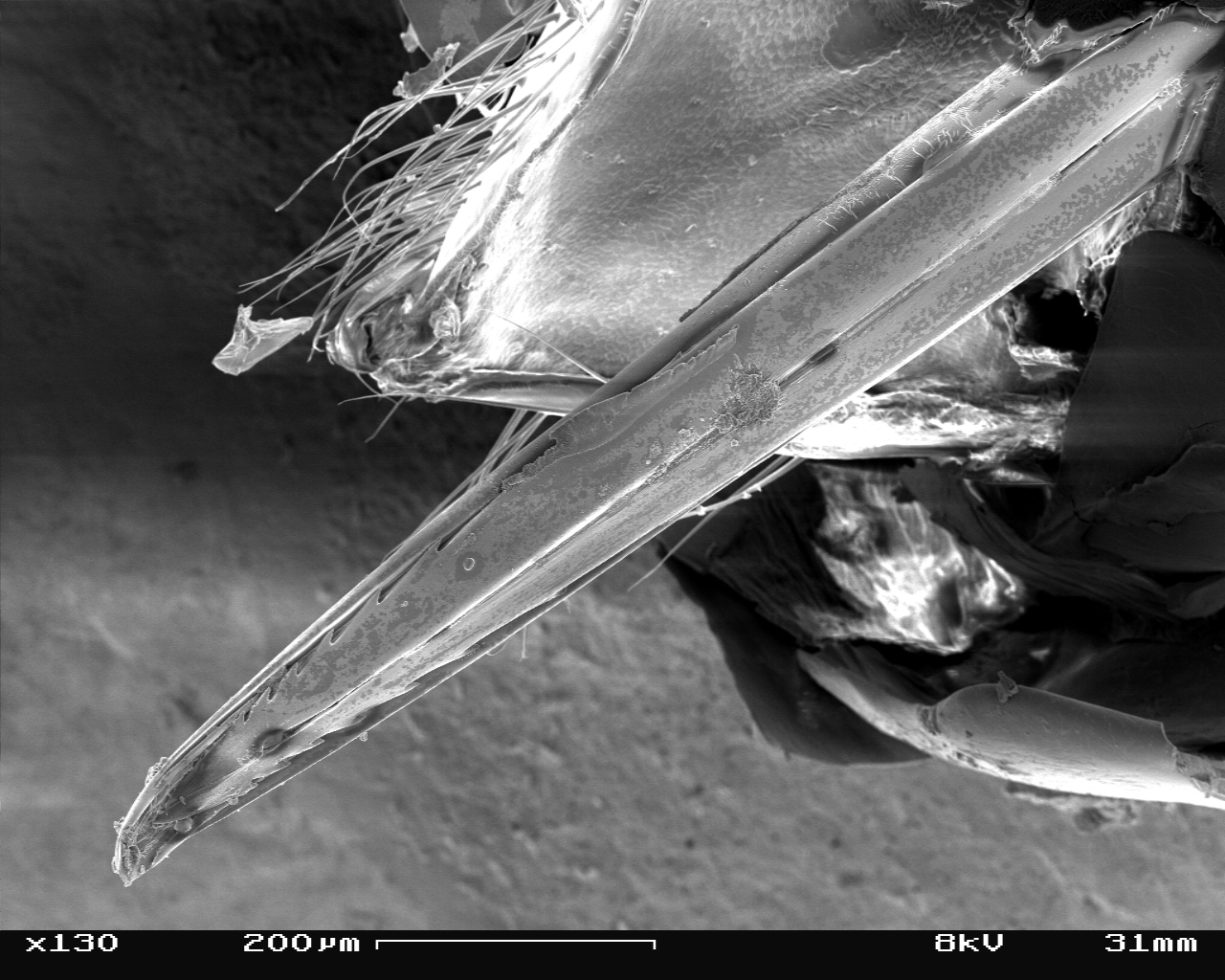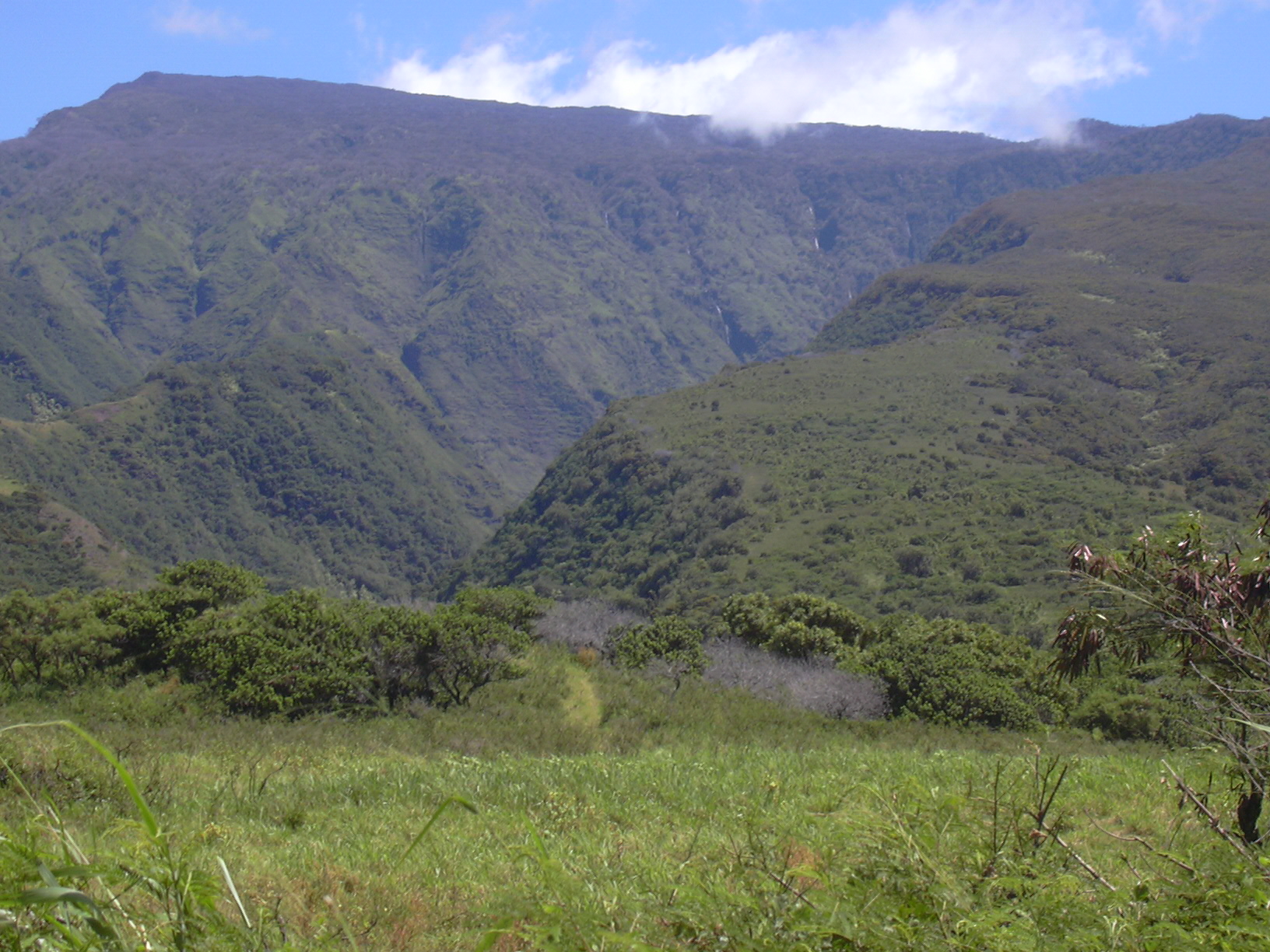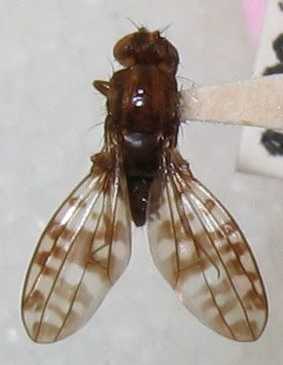|
Drosophila Differens
''Drosophila differens'' is an endangered species of Hawaiian fly in the family Drosophilidae. This species is a member of the ''planitiba'' subgroup of the picture-wing clade of Hawaiian ''Drosophila''. It is found on the island of Molokai. Description ''Drosophila differens'' was described by D. Elmo Hardy and Kenneth Y. Kaneshiro in 1975. This fly is very similar to its Maui relative, '' D. planitibia'', though most individuals of ''D. differens'' has a yellow face while ''D. planitibia'' have a black face. However, Hardy and Kaneshiro report that it is difficult to find any consistently distinguishing character. These two species are capable of hybridizing, but crosses in both directions produce sterile males. ''D. differens'' is larger than many other picture-wing species. It is reported to breed in the rotting bark of ''Clermontia'' species. Conservation ''Drosophila hemipeza'' was listed as federally endangered in 2006 along with ten other species of picture-wing '' ... [...More Info...] [...Related Items...] OR: [Wikipedia] [Google] [Baidu] |
Endangered Species
An endangered species is a species that is very likely to become extinct in the near future, either worldwide or in a particular political jurisdiction. Endangered species may be at risk due to factors such as habitat loss, poaching and invasive species. The International Union for Conservation of Nature (IUCN) Red List lists the global conservation status of many species, and various other agencies assess the status of species within particular areas. Many nations have laws that protect conservation-reliant species which, for example, forbid hunting, restrict land development, or create protected areas. Some endangered species are the target of extensive conservation efforts such as captive breeding and habitat restoration. Human activity is a significant cause in causing some species to become endangered. Conservation status The conservation status of a species indicates the likelihood that it will become extinct. Multiple factors are considered when assessing the ... [...More Info...] [...Related Items...] OR: [Wikipedia] [Google] [Baidu] |
Drosophilidae
The Drosophilidae are a diverse, cosmopolitan family of flies, which includes species called fruit flies, although they are more accurately referred to as vinegar or pomace flies. Another distantly related family of flies, Tephritidae, are true fruit flies because they are frugivorous, and include apple maggot flies and many pests. The best known species of the Drosophilidae is ''Drosophila melanogaster'', within the genus ''Drosophila'', also called the "fruit fly." ''Drosophila melanogaster'' is used extensively for studies concerning genetics, development, physiology, ecology and behaviour. Many fundamental biological mechanisms were discovered first in ''D. melanogaster.'' The fruit fly is mostly composed of post-mitotic cells, has a very short lifespan, and shows gradual aging. As in other species, temperature influences the life history of the animal. Several genes have been identified that can be manipulated to extend the lifespan of these insects. Additionally, ''Drosophi ... [...More Info...] [...Related Items...] OR: [Wikipedia] [Google] [Baidu] |
Hawaiian Drosophila
The Hawaiian Drosophilidae are a lineage of flies within the genus ''Drosophila.'' This monophyletic clade includes all of the endemic Hawaiian ''Drosophila'' and all members of the genus '' Scaptomyza'', which contains both Hawaiian and non-Hawaiian species. The Hawaiian Drosophilidae are descended from a common ancestor estimated to have lived 25 million years ago. Species of Hawaiian Drosophilidae flies have been studied as models of speciation and behavioral evolution. Along with other members of the native Hawaiian ecosystem, the conservations status of many species of Hawaiian Drosophilidae is threatened by habitat loss and introduced predators, among other factors. Diversity There are an estimated 1,000 species of Hawaiian Drosophilidae. 689 species have been described, including 273 species in the genus '' Scaptomyza'', of which 148 are endemic to the Hawaiian archipelago, and 416 Hawaiian endemic species in the genus ''Drosophila.'' Within the Hawaiian ''Drosophila'' ... [...More Info...] [...Related Items...] OR: [Wikipedia] [Google] [Baidu] |
Molokai
Molokai , or Molokai (), is the fifth most populated of the eight major islands that make up the Hawaiian Islands, Hawaiian Islands archipelago in the middle of the Pacific Ocean. It is 38 by 10 miles (61 by 16 km) at its greatest length and width with a usable land area of , making it the fifth-largest in size of the main Hawaiian Islands and the List of islands of the United States by area, 27th largest island in the United States. It lies southeast of Oahu, Oahu across the wide Hawaiian islands channels, Kaʻiwi Channel and north of Lanai, Lānai, separated from it by the Hawaiian islands channels, Kalohi Channel. The island's agrarian economy has been driven primarily by cattle ranching, pineapple production, sugarcane production and small-scale farming. Tourism comprises a small fraction of the island's economy, and much of the infrastructure related to tourism was closed and barricaded in the early 2000s when the primary landowner, Molokai Ranch, ceased operations due ... [...More Info...] [...Related Items...] OR: [Wikipedia] [Google] [Baidu] |
Maui
The island of Maui (; Hawaiian: ) is the second-largest of the islands of the state of Hawaii at 727.2 square miles (1,883 km2) and is the 17th largest island in the United States. Maui is the largest of Maui County's four islands, which also includes Molokai, Lānai, and unpopulated Kahoolawe. In 2020, Maui had a population of 168,307, the third-highest of the Hawaiian Islands, behind that of Oahu and Hawaii Island. Kahului is the largest census-designated place (CDP) on the island with a population of 26,337 , and is the commercial and financial hub of the island. Wailuku is the seat of Maui County and is the third-largest CDP . Other significant places include Kīhei (including Wailea and Makena in the Kihei Town CDP, the island's second-most-populated CDP), Lāhainā (including Kāanapali and Kapalua in the Lāhainā Town CDP), Makawao, Pukalani, Pāia, Kula, Haikū, and Hāna. Etymology Native Hawaiian tradition gives the origin of the island's name in th ... [...More Info...] [...Related Items...] OR: [Wikipedia] [Google] [Baidu] |
Drosophila Planitibia
''Drosophila'' () is a genus of flies, belonging to the family Drosophilidae, whose members are often called "small fruit flies" or (less frequently) pomace flies, vinegar flies, or wine flies, a reference to the characteristic of many species to linger around overripe or rotting fruit. They should not be confused with the Tephritidae, a related family, which are also called fruit flies (sometimes referred to as "true fruit flies"); tephritids feed primarily on unripe or ripe fruit, with many species being regarded as destructive agricultural pests, especially the Mediterranean fruit fly. One species of ''Drosophila'' in particular, ''D. melanogaster'', has been heavily used in research in genetics and is a common model organism in developmental biology. The terms "fruit fly" and "''Drosophila''" are often used synonymously with ''D. melanogaster'' in modern biological literature. The entire genus, however, contains more than 1,500 species and is very diverse in appearance, beha ... [...More Info...] [...Related Items...] OR: [Wikipedia] [Google] [Baidu] |
Clermontia
The Hawaiian lobelioids are a group of flowering plants in the bellflower family, Campanulaceae, subfamily Lobelioideae, all of which are endemic to the Hawaiian Islands. This is the largest plant radiation in the Hawaiian Islands, and indeed the largest on any island archipelago, with over 125 species. The six genera involved can be broadly separated based on growth habit: ''Clermontia'' are typically branched shrubs or small trees, up to tall, with fleshy fruits; ''Cyanea'' and ''Delissea'' are typically unbranched or branching only at the base, with a cluster of relatively broad leaves at the apex and fleshy fruits; ''Lobelia'' and ''Trematolobelia'' have long thin leaves down a single, non-woody stem and capsular fruits with wind-dispersed seeds; and the peculiar ''Brighamia'' have a short, thick stem with a dense cluster of broad leaves, elongate white flowers, and capsular fruits. The relationships among the genera and sections remains unsettled . Many species have beauti ... [...More Info...] [...Related Items...] OR: [Wikipedia] [Google] [Baidu] |
Yellowjacket
Yellowjacket or yellowjacket is the common name in North America for predatory social wasps of the genus, genera ''Vespula'' and ''Dolichovespula''. Members of these genera are known simply as "wasps" in other English-speaking countries. Most of these are black and yellow like the eastern yellowjacket ''Vespula maculifrons'' and the aerial yellowjacket ''Dolichovespula arenaria''; some are black and white like the bald-faced hornet, ''Dolichovespula maculata''. Others may have the abdomen background color red instead of black. They can be identified by their distinctive markings, their occurrence only in colonies, and a characteristic, rapid, side-to-side flight pattern prior to landing. All females are capable of stinger, stinging. Yellowjackets are important predators of pest insects. Identification Yellowjackets may be confused with other wasps, such as hornets and paper wasps such as ''Polistes dominula''. A typical yellowjacket worker is about long, with alternating ban ... [...More Info...] [...Related Items...] OR: [Wikipedia] [Google] [Baidu] |
Psidium Cattleyanum
''Psidium cattleyanum (World Plants : Psidium cattleianum)'', commonly known as Cattley guava, strawberry guava or cherry guava, is a small tree (2–6 m tall) in the Myrtaceae (myrtle) family. The species is named in honour of English horticulturist William Cattley. Its genus name ''Psidium'' comes from the Latin ''psidion'', or "armlet." The red-fruited variety, ''P. cattleyanum var. cattleyanum'', is commonly known as purple guava, red cattley guava, red strawberry guava and red cherry guava. The yellow-fruited variety, ''P. cattleyanum var. littorale'' is variously known as yellow cattley guava, yellow strawberry guava, yellow cherry guava, lemon guava and in Hawaii as ''waiawī''. Although ''P. cattleyanum'' has select economic uses,US Forest Service. (2016). Strawberry Guava: Not All Green Is Good. Pacific Southwest Research Station. it is considered the most invasive plant in Hawaii.Lowe S., Browne M., Boudjelas S., De Poorter M. (2000) ''100 of the World’s Worst ... [...More Info...] [...Related Items...] OR: [Wikipedia] [Google] [Baidu] |
Axis Deer
The chital or cheetal (''Axis axis''; ), also known as the spotted deer, chital deer, and axis deer, is a deer species native to the Indian subcontinent. It was first described and given a binomial name by German naturalist Johann Christian Polycarp Erxleben in 1777. A moderate-sized deer, male chital reach and females at the shoulder. While males weigh , females weigh around . It is sexually dimorphic; males are larger than females, and antlers are present only on males. The upper parts are golden to rufous, completely covered in white spots. The abdomen, rump, throat, insides of legs, ears, and tail are all white. The antlers, three-pronged, are nearly long. Etymology The vernacular name "chital" (pronounced ) comes from ''cītal'' ( hi, चीतल), derived from the Sanskrit word ' (चित्रल), meaning "variegated" or "spotted". The name of the cheetah has a similar origin. Variations of "chital" include "cheetal" and "cheetul". Other common names for the chit ... [...More Info...] [...Related Items...] OR: [Wikipedia] [Google] [Baidu] |
Drosophila
''Drosophila'' () is a genus of flies, belonging to the family Drosophilidae, whose members are often called "small fruit flies" or (less frequently) pomace flies, vinegar flies, or wine flies, a reference to the characteristic of many species to linger around overripe or rotting fruit. They should not be confused with the Tephritidae, a related family, which are also called fruit flies (sometimes referred to as "true fruit flies"); tephritids feed primarily on unripe or ripe fruit, with many species being regarded as destructive agricultural pests, especially the Mediterranean fruit fly. One species of ''Drosophila'' in particular, ''D. melanogaster'', has been heavily used in research in genetics and is a common model organism in developmental biology. The terms "fruit fly" and "''Drosophila''" are often used synonymously with ''D. melanogaster'' in modern biological literature. The entire genus, however, contains more than 1,500 species and is very diverse in appearance, be ... [...More Info...] [...Related Items...] OR: [Wikipedia] [Google] [Baidu] |
Insects Described In 1975
Insects (from Latin ') are pancrustacean Hexapoda, hexapod invertebrates of the class (biology), class Insecta. They are the largest group within the arthropod phylum. Insects have a chitinous exoskeleton, a three-part body (head, Thorax (insect anatomy), thorax and abdomen (insect anatomy), abdomen), three pairs of jointed Arthropod leg, legs, compound eyes and one pair of antenna (biology), antennae. Their blood is not totally contained in vessels; some circulates in an open cavity known as the haemocoel. Insects are the most diverse group of animals; they include more than a million described species and represent more than half of all known living organisms. The total number of Extant taxon, extant species is estimated at between six and ten million; In: potentially over 90% of the animal life forms on Earth are insects. Insects may be found in nearly all Natural environment, environments, although only a small number of species reside in the oceans, which are dominated by ... [...More Info...] [...Related Items...] OR: [Wikipedia] [Google] [Baidu] |





.jpg)


_male.jpg)

